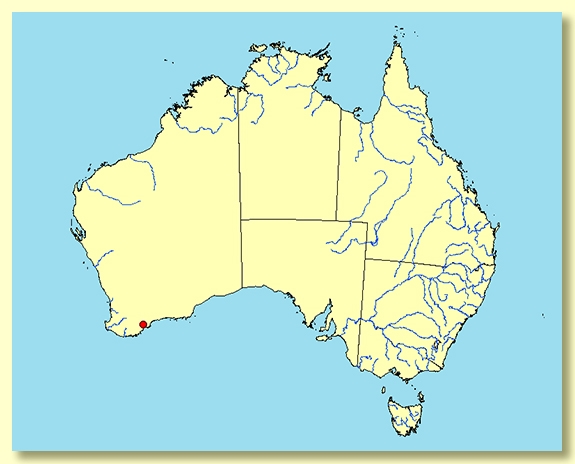Eucalyptus | Symphyomyrtus | Bisectae | Hadrotes | Lehmannianae | Conjunctae
Euclid - Online edition
Eucalyptus sinuosa
Mallee up to 4 m tall. Forming a lignotuber.
Bark smooth throughout, cream, grey to grey-brown and orange-brown, shedding in ribbons.
Branchlets lack oil glands in the pith.
Juvenile growth (coppice or field seedlings to 50 cm): not seen.
Adult leaves alternate, petioles 0.2–0.5 cm long; blade linear, 5-7.5 cm long, 0.4-0.7(0.9) cm wide, base tapering to petiole, margin entire but with marginal black lenticels, apex usually rounded or pointed and apiculate/warty, concolorous, glossy, green, reticulation ? moderate, intramarginal veins prominent and remote from margin such that the blade appears to have 3 main parallel veins, oil glands obscure or scattered.
Inflorescence axillary unbranched, peduncles terete, down-curved by time of flowering, 4.5-10(14) cm long; buds 11-25(30) per umbel which is syncarpous, pedicels absent. All the buds in an umbel are completely joined by the hypanthium (base) only, the upper part of each bud remains free; at maturity the combined length of the fused part plus operculum is ca 6-11 cm. Scar left by the early shedding of the outer (sepaline) operculum is often difficult to see; inner (petaline) operculum always curved to sinuous, 5 to 10 times as long as the fused part of the bud (the inner operculum at maturity is 5-9.5 cm long and is widest at its base being 0.7–1.1 cm); stamens completely erect, anthers narrowly oblong, versatile, dorsifixed, dehiscing by longitudinal slits, style long and straight, stigma blunt to broadly conical, locules 3, the placentae each with ?4 vertical rows of ovules. Flowers green-yellow.
Fruit on rigidly down-turned peduncles, syncarpous, the individual capsules in the woody mass 1.2-1.4 cm wide, length not measurable, dehiscing by elliptical holes formed as the 3 valves split along the sutures but remain ± connected apically, disc covers the surface of the valves and appears striate.
Seeds blackish, 1.5–2.5 mm long, ovoid to more or less angularly so, dorsal surface scarcely reticulate, hilum ventral/terminal.
Cultivated seedlings (measured at node 10): cotyledons Y-shaped (bisected); stems triangular but soon becoming rounded in cross-section, scabrid throughout; leaves always petiolate, opposite ca 4-5 nodes then alternate, ovate-deltoid to ovate, 3–5 cm long, 2–3.5 cm wide, dull grey-green to green, lamina scabrid becoming sparsely so.
Flowering has been recorded in November, but bud clusters in varying stages of development at any one time on an individual plant have been noted in the field and the flowering period is likely to be wider than this.
A smooth-barked mallee endemic to the sub-coastal sandplains of southern Western Australia sporadically distributed from near Ongerup to Jerramungup and Fitzgerald River National Park, on granitic sands in mallee heath on gentle slopes. It is distinguished by its glossy green narrow leaves and clusters of buds that are fused at the base and have free opercula up to 9.5 cm long. The long opercula are curved to sinuose in the upper third and are slightly dilated and warty at the ends. When in flower the long greenish yellow stamens of the clustered flowers form spectacular balls.
Eucalyptus sinuosa belongs in Eucalyptus subgenus Symphyomyrtus section Bisectae subsection Hadrotes because the cotyledons are coarsely bisected, buds have an operculum scar, a long (inner) operculum and erect stamens, fruit which are large, thick-rimmed and held rigidly. Of the twelve species in subsection Hadrotes ten lack oil glands in the pith of the branchlets and have scabrid seedlings. Together these ten species form series Lehmannianae, a group further characterised by having fruit with exserted valves that remain fused at their tips after seed shed, a feature shared with the more distantly related E. cornuta (but not with E. macrandra).
Of the ten species in series Lehmannianae six, E. lehmannii, E. conferruminata, E. mcquoidii, E. arborella, E. sinuosa and E. retusa, have the buds (and fruit) in each axillary cluster fused basally whilst the other four species, E. newbeyi, E. burdettiana, E. talyuberlup, and E. megacornuta, have buds and fruit free.
Eucalyptus sinuosa is distinguished from the other 6 species with fused buds and fruit by the combination of terete peduncle, exceptionally long operculum that is sinuose distally, the narrow adult leaves and lignotuberous habit. The only other species that shares the terete peduncle character with E. sinuosa is E. mcquoidii which differs in lacking a lignotuber and having generally greater numbers of buds per cluster (21 to 50 buds per umbel, whilst E. sinuosa has 11-25(30)), more or less straight opercula that are shorter and decidedly narrower basally, and coastal headland habitat.
Eucalyptus sinuosa: from the Latin sinuosus, characterized by bends, referring to the features of the (inner) operculum of the mature flower buds.






